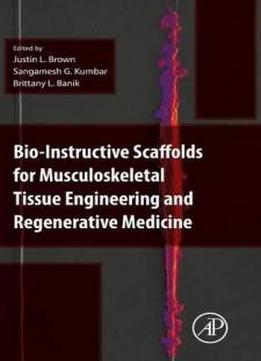
Bio-instructive Scaffolds For Musculoskeletal Tissue Engineering And Regenerative Medicine
by Sangamesh Kumbar /
2016 / English / PDF
18.6 MB Download
Bio-Instructive Scaffolds for Musculoskeletal Tissue
Engineering and Regenerative Medicine
Bio-Instructive Scaffolds for Musculoskeletal Tissue
Engineering and Regenerative Medicine explores
musculoskeletal tissue growth and development across populations,
ranging from elite athletes to the elderly. The regeneration and
reparation of musculoskeletal tissues present the unique
challenges of requiring both the need to withstand distinct
forces applied to the body and ability to support cell
populations.
explores
musculoskeletal tissue growth and development across populations,
ranging from elite athletes to the elderly. The regeneration and
reparation of musculoskeletal tissues present the unique
challenges of requiring both the need to withstand distinct
forces applied to the body and ability to support cell
populations.
The book is separated into sections based on tissue type,
including bone, cartilage, ligament and tendon, muscle, and
musculoskeletal tissue interfaces. Within each tissue type, the
chapters are subcategorized into strategies focused on cells,
hydrogels, polymers, and other materials (i.e. ceramics and
metals) utilized in musculoskeletal tissue engineering
applications.
The book is separated into sections based on tissue type,
including bone, cartilage, ligament and tendon, muscle, and
musculoskeletal tissue interfaces. Within each tissue type, the
chapters are subcategorized into strategies focused on cells,
hydrogels, polymers, and other materials (i.e. ceramics and
metals) utilized in musculoskeletal tissue engineering
applications.
In each chapter, the relationships that exist amongst the
strategy, stem cell differentiation and somatic cell
specialization at the intracellular level are emphasized.
Examples include intracellular signaling through growth factor
delivery, geometry sensing of the surrounding network, and cell
signaling that stems from altered population dynamics.
In each chapter, the relationships that exist amongst the
strategy, stem cell differentiation and somatic cell
specialization at the intracellular level are emphasized.
Examples include intracellular signaling through growth factor
delivery, geometry sensing of the surrounding network, and cell
signaling that stems from altered population dynamics.Presents a self-contained work for the field of
musculoskeletal tissue engineering and regenerative medicine
Presents a self-contained work for the field of
musculoskeletal tissue engineering and regenerative medicineFocuses on how materials of structures can be designed to be
resistant while promoting viable grafts
Focuses on how materials of structures can be designed to be
resistant while promoting viable graftsContains major tissue types that are covered with a strategy
for each material and structure
Contains major tissue types that are covered with a strategy
for each material and structure











